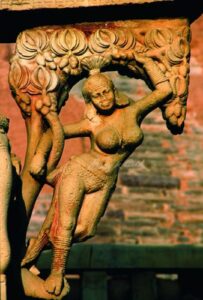BEYOND THE ILLUSORY WORLD

North Gateway, Inner View, Great Stupa, Sanchi
Benoy K Behl
One of the oldest known sacred forms in India is the Stupa. It is seen in Buddhist and Jaina monuments, from early times. Recent excavations near Nalanda have also unearthed a large mud stupa of the 8th to the 10th century BCE. This may be of the Ajivikas, a deeply ascetic sect.
The story of Indian philosophy and its art is the story of the constant search for the truth which is eternal and beyond the passing shadows of the material world which we see around us.
The forms and attractions of the world around us are termed as ‘Maya’ or ‘Mithya’, an illusion. We remain caught in a web of ‘Samsara’ or illusion. The aim of the philosophic journey, and of the art which aids this quest, is to lift the veils of this illusion, for us to see that which is true and lasting.

In 483 BCE, Gautama Buddha attained Parinirvana, the final escape from the illusions of the material world. His followers divided his mortal relics and enshrined them in the heart of mud stupas which were made. Thus began a tradition which spread to many countries and continues till today. Later stupas housed the remains of other great teachers, their personal belongings and also Buddhist texts.
In the 3rd century BCE, Emperor Ashoka is believed to have retrieved the Buddha’s holy relics and enshrined them again, in stupas which he constructed across his kingdom.
The rule of the Mauryas was followed by that of the Sunga dynasty, in the 2nd and 1st centuries BCE. The earliest body of Buddhist art, with images of the life of the Buddha and Jataka stories, was made under their rule.
Around 100 BCE, a great stupa was made at Bharhut, in the eastern part of present-day Madhya Pradesh. Between the sacred and unadorned form of the stupas and the mundane world beyond, were made vedikas or railings, and toranas or gateways. The railings create a path for the devotee to walk around the revered stupa.
Forms of the world around us were made on the railings and gateways. Their representations helped us to appreciate all forms of life in their true perspective to see them as reflections of the formless eternal truth towards which we must proceed. Beyond the railings and gateways is the stupa to point out the truth towards which we must strive leaving behind the attractions and attachments to the world. The nine- foot high of vedikas and toranas are made in imitation of the wooden architecture of that time
This film covers the making of early stupas and their sculpted railings. We see the site of Bharhut, the railings in the Indian Museum Kolkata and the stupas of Sanchi (2nd century BCE-1st century CE).
Under its series Glimpses Of Culture, India Habitat Centre is presenting a talk by Art Historian,
Film-maker & Photographer (and the author of this article) Benoy K Behl on December 9, at 6pm.
A film Beyond the Illusory World (produced by Behl for Doordarshan) will also be screened on the occasion. After the Indus Valley Civilization, this is Part 2 of Behl’s tracing of the Roots of Indian art.
Click here to join

